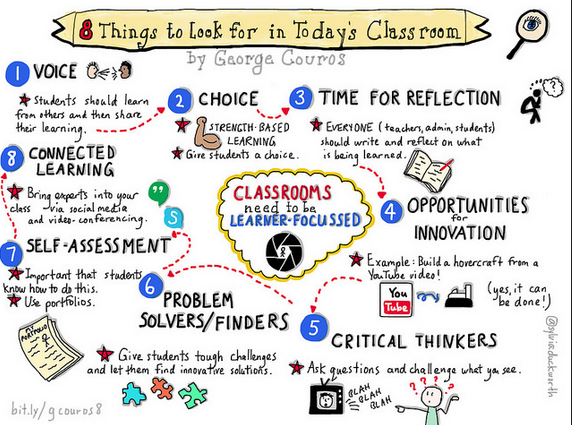
In my new book, “The Innovator’s Mindset“, one of the things that I discuss is understanding that we are not able to change others, but are able to create the conditions where change is more likely to happen. Instead of pointing fingers at others, it is important to recognize what we have the ability to do, and develop conditions where innovation is more likely to happen.
Below are five focuses I share in the book on how to “Unleash Talent”, with a quick synopsis and some questions.
1.Powerful Learning First, Technology Second
Although the words “innovation” and “technology” are not synonymous, we do have to understand that technology can be transformational in our learning. When we immerse ourselves in learning experiences with technology, it helps us to make better decisions on what type of learning can truly happen in our schools. For example, if a student wanted to play violin, and there was no one in your organization that knew how to play, where would they go? YouTube most likely, yet if it is blocked, what opportunities have we cut off from our students? When purchasing technology in our schools, these should be informed decisions on what is best for learning, not on what technology is cheapest or what people are most used to.
Questions to Consider:
- How do you model and explore new opportunities for learning in your own practice?
- What opportunities are you providing for informal learning, exploration, and “play”, with new technologies in your organization?
2. Strengths-Based Leadership
It is tremendously hard for people to be innovative in an area they hate. That is why Jim Collins talks about not only getting the right people in the bus, but also getting those people in the right seats. One superintendent I worked with this year, Juan Cabrera, stated that it is better to find the best people and fit jobs around them, as opposed to create jobs and try to fit people into them. Tapping into the strengths of people as opposed to constantly focus on their weaknesses, develops confidence and competence along the way. If you cannot identify the strengths of the people you serve, they might not be the problem.
Questions to Consider:
- What are the current strengths of your organization, and how do you continue to move them forward?
- What ways are you tapping into these strengths?
3. Less Is More
If you truly think about the areas that your school or district is focusing on, are there more than three? If you asked twenty people in your school what are the main focuses of your school, would they all have the same answer? An analogy that I have heard recently is that teachers don’t have too much on their plate, but they actually have a platter. This needs to change. Instead of trying to do everything (ultimately poor to average), we need to focus on a few things that we can excel at that will eventually become common strengths. The best organizations will come back to and revisit something over and over again throughout the year, as opposed to simply moving on to the next thing. We need to focus more on depth than breadth.
Questions to Consider:
- What initiatives are you focusing on in your school district?
- What would you take off the plate?
4. Create Meaningful Learning Experiences for Educators
We often create what we experience, yet there are too many times where we are told what a classroom and learning should look like, as opposed to experiencing it in our classrooms. It is important to provide information and context, but do we make time to dig deep. If you think of things such as “EdCamps”, that experience is mostly used for adult learning, but then “Maker Spaces” are mostly used by students. If they are great learning experiences, they should be for all learners, not just a certain group. The question you want to hear from professional learning is, “That was amazing…how do we do this in our classrooms?” We cannot have one type of practice for our learning, and then expect things to change in our classrooms.
Questions to Consider:
- How do you both personalize learning opportunities while moving the co-created vision forward for your school/organization?
- Which elements of the “8 Things to Look for in Today’s Classroom” do you already see in your professional learning opportunities? What elements are lacking?

5. Embrace an Open Culture
How do we make great learning go viral? This is a key question in how we move from “pockets of innovation” to a “culture of innovation”? Social media is powerful for making global connections, but how do we break down these walls in our own schools. Here is one suggestion:

Everything you need to create a “culture of innovation” is probably already in your school; we just need to bring it to the forefront.
Questions to Consider:
- How are you actively sharing your learning with your school and global community?
- How do you make the great learning go “viral” in your school, to move from “pockets” to a “culture of innovation?”
These are not in any specific order, but all things we should focus on to move forward as an organizations. I go deeper into each area in my book, but would love to hear your ideas on how these things are brought to life in the context of your own schools.
